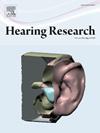耳间连贯、耳间水平差异与双耳融合的关系。
IF 2.5
2区 医学
Q1 AUDIOLOGY & SPEECH-LANGUAGE PATHOLOGY
引用次数: 0
摘要
双耳融合是当信号被呈现到两只耳朵时,对单个听觉图像的感知。降低双耳信号的相干性往往会降低双耳融合。然而,听觉连贯变化对听觉水平差异(ILDs)的影响最小。本研究旨在确定在双耳连贯性降低的情况下,ILDs和双耳融合之间是否存在相互作用。在实验1中,不同包络间相干性的声编码刺激包含了一系列的ild。参与者指出了他们所感知到的听觉图像的大小和侧边化。当存在较大的ILD时,即使参与者表示当存在0 dB ILD时,同样的刺激也会被融合。这表明,当刺激具有较大的ILDs时,低耳间相干性的信号可以成为双耳融合。为了确定参与者是否可以选择只关注一只耳朵,以应对实验1中报告的在存在ild的情况下融合的刺激(即如果发生了完全的双耳融合),参与者指出了实验2中不同右耳强度刺激在他们右耳中的感知响度。当刺激具有左偏ILD时,参与者报告右耳信号强度变化的能力降低,这表明大ILD的存在促进了双耳融合的很大程度上完全。本文章由计算机程序翻译,如有差异,请以英文原文为准。
The relationship between interaural coherence, interaural level differences, and binaural fusion
Binaural fusion is the perception of a single auditory image when signals are presented to the two ears. Decreasing the interaural coherence of the signals often degrades binaural fusion. However, perception of interaural level differences (ILDs) is minimally affected by interaural coherence changes. This study aims to determine if there is an interaction between ILDs and binaural fusion in the presence of reduced interaural coherence.
In Experiment 1, vocoded stimuli with varying envelope interaural coherences were presented containing a range of ILDs. Participants indicated the perceived size and lateralization of the auditory image they perceived. Stimuli with reduced interaural coherence were binaurally fused when there was a large ILD, even when participants indicated that the same stimulus was unfused when there was a 0 dB ILD. This suggests that signals with low interaural coherence can become binaurally fused when the stimulus has large ILDs.
To determine if participants could choose to attend to only one ear for stimuli that were reported to be fused in the presence of ILDs in Experiment 1 (i.e. if complete binaural fusion occurred), participants indicated the perceived loudness in their right ear for stimuli with varying right-ear intensities in Experiment 2. When the stimulus had a left-biased ILD, participants had a reduced ability to report changes in right ear signal intensity, suggesting that largely complete binaural fusion was fostered by the presence of large ILDs.
求助全文
通过发布文献求助,成功后即可免费获取论文全文。
去求助
来源期刊

Hearing Research
医学-耳鼻喉科学
CiteScore
5.30
自引率
14.30%
发文量
163
审稿时长
75 days
期刊介绍:
The aim of the journal is to provide a forum for papers concerned with basic peripheral and central auditory mechanisms. Emphasis is on experimental and clinical studies, but theoretical and methodological papers will also be considered. The journal publishes original research papers, review and mini- review articles, rapid communications, method/protocol and perspective articles.
Papers submitted should deal with auditory anatomy, physiology, psychophysics, imaging, modeling and behavioural studies in animals and humans, as well as hearing aids and cochlear implants. Papers dealing with the vestibular system are also considered for publication. Papers on comparative aspects of hearing and on effects of drugs and environmental contaminants on hearing function will also be considered. Clinical papers will be accepted when they contribute to the understanding of normal and pathological hearing functions.
 求助内容:
求助内容: 应助结果提醒方式:
应助结果提醒方式:


